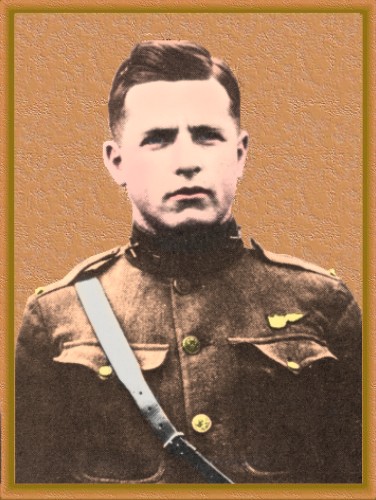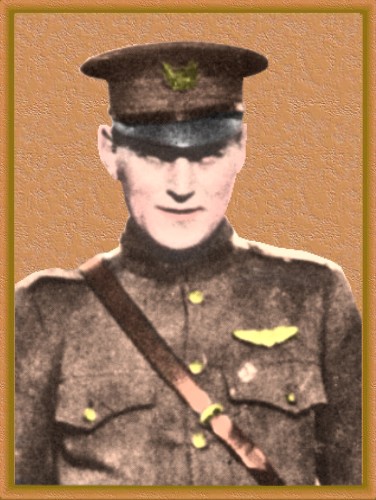


Rank, duty position and unit at time of action:
Second Lieutenant, Aerial Observer, 50th Aero Squadron, Air Service, American Expeditionary Force

Rank, duty position and unit at time of action:
First Lieutenant, Pilot, 50th Aero Squadron, Air Service, American Expeditionary Force
War:
World War I
Place and date of action:
Argonne forest, France, 6 October 1918
Should have been portrayed in the film:
*BLECKLEY, ERWIN R. (Air Mission)
Rank and organization: Second Lieutenant, U.S. Army Air Corps, 130th Field Artillery, observer 50th Aero Squadron, Air Service. Place and date. Near Binarville, France, 6 October 1918. Entered service at: Wichita, Kans. Birth: Wichita, Kans. G.O. No.: 56, W.D., 1922. Citation: 2d Lt. Bleckley, with his pilot, 1st Lt. Harold E. Goettler, Air Service, left the airdrome late in the afternoon on their second trip to drop supplies to a battalion of the 77th Division, which had been cut off by the enemy in the Argonne Forest. Having been subjected on the first trip to violent fire from the enemy, they attempted on the second trip to come still lower in order to get the packages even more precisely on the designated spot. In the course of his mission the plane was brought down by enemy rifle and machinegun fire from the ground, resulting in fatal wounds to 2d Lt. Bleckley, who died before he could be taken to a hospital. In attempting and performing this mission 2d Lt. Bleckley showed the highest possible contempt of personal danger, devotion to duty, courage, and valor.
*GOETTLER, HAROLD ERNEST (Air Mission)
Rank and organization: First Lieutenant, pilot, U.S. Army Air Corps, 50th Aero Squadron, Air Service. Place and date: Near Binarville, France, 6 October 1918. Entered service at: Chicago, Ill. Born: 21 July 1890, Chicago, Ill. G.O. No.: 56, W.D., 1922. Citation: 1st. Lt. Goettler, with his observer, 2d Lt. Erwin R. Bleckley, 130th Field Artillery, left the airdrome late in the afternoon on their second trip to drop supplies to a battalion of the 77th Division which had been cut off by the enemy in the Argonne Forest. Having been subjected on the first trip to violent fire from the enemy, they attempted on the second trip to come still lower in order to get the packages even more precisely on the designated spot. In the course of this mission the plane was brought down by enemy rifle and machinegun fire from the ground, resulting in the instant death of 1st. Lt. Goettler. In attempting and performing this mission 1st. Lt. Goettler showed the highest possible contempt of personal danger, devotion to duty, courage and valor.
The actions involving the so-called "Lost Battalion" actually resulted in the awarding of five Medals of Honor. Three infantry officers were appropriately depicted in the film The Lost Battalion (2001), but aviators Erwin Bleckley and Harold Goettler were so misrepresented as to earn the film this second entry under the Blown Opportunities category.
The nickname "The Lost Battalion", coined by the wire service war correspondents at the time, was an oversimplified misnomer of the forces involved, which were actually two battalions of one regiment and companies from two other regiments, all part of the 77th Infantry Division. They were part of the October 1918 Meuse-Argonne Offensive; the approximately 700 men of these units became isolated in a pocket and surrounded by the Germans at Charlevaux Mill in the Argonne Forest on 2 October. They had remained on their objective, not realizing, due to poor communications, that the remainder of the 77th Division and the other adjacent units had stalled in their advance and then retired to their original Line of Departure. With communications cut off and only a day's worth of rations, for the next five days, the Lost Battalion endured repeated assaults from the Germans, starvation, and friendly fire casualties from American artillery which was attempting to fire on the attacking Germans with faulty information.
As members of the 50th Aero Squadron flying a DH-4 attack/reconaissance aircraft, pilot Goettler and aerial observer Bleckley were part of the effort to pinpoint the location of the Lost Battalion, and to drop supplies to them. Poor weather and the thick foliage of the Argonne Forest resulted in more of the supplies ending up in German hands than those of the intended recipients, and the 50th Squadron lost two DH-4s to German ground fire with others often returning to base riddled with bullet holes. On 6 October, Bleckley and Goettler returned from their first sortie with battle damage and frustrated by yet another unsuccessful mission. After helping their ground crew repair the damage, they volunteered for a second sortie, agreeing to fly at treetop level; that sortie, they located and pinpointed the front line traces of both the Lost Battalion and the surrounding Germans, but both men were wounded by ground fire. Their DH-4 crash-landed on Allied lines; Goettler was found dead in the cockpit and Bleckley died enroute to the hospital, but his notes and map annotations allowed the Americans to fire more accurate artillery on the Germans and to mount a relief effort which eventually broke through to the Lost Battalion. Bleckley and Goettler were posthumously awarded the Medal of Honor for this action. They accounted for two of the four Medals of Honor awarded to Army aviators in World War I, the other two going to fighter aces Frank Luke and Eddie Rickenbacker, the latter also having a Blown Opportunities entry on this website.
Unfortunately, in this film, Bleckley's and Goettler's actions were depicted as being done by a single unnamed pilot with an indeterminate foreign accent in a very brief speaking role, flying a British-made single seat SE-5 fighter with French markings. While the authors fully understand and appreciate the limited availability of authentic World War I-vintage warplanes of all models, this segment of the film is still inexplicable on at least two counts: why the French would be flying a British-built fighter, and why they would have been flying this mission in place of Bleckley and Goettler and the rest of the US 50th Aero Squadron. In addition to this film obliterating the heroism and memory of these two Americans, it is further ironic to note that while American fighter units in World War I did fly French-built airplanes, the DH-4, although based on a British design, was the only US-built airplane to see combat in that conflict.